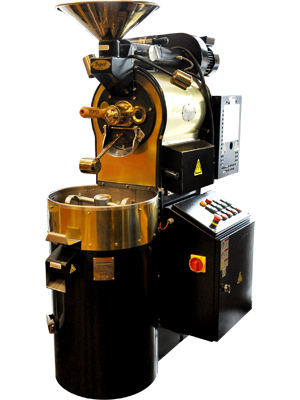Maintenance and cleaning of coffee roaster
For professional coffee roasters, clogged pipes are always a headache. Coffee beans roast at the same time will produce oil smoke, this oil smoke is not only exhaust gas, but also mixed with a large number of silver skin dust, as well as raw beans entrained dust impurities, as long as the coffee roaster continues to run, this kind of oil smoke full of impurities and dust will continue to produce and exhaust, highly viscous oil smoke dust will gradually adhere to the surface of the object in contact, and proliferation, thickening, and finally cause the exhaust pipe blockage. Blockage doesn't have to wait until your pipes are completely blocked, as long as it accumulates to a certain thickness, it has a significant impact on the roast quality of coffee beans and cup performance.
Blockage can occur anywhere from dampers, fan blades, dust buckets, electrostatic motors, to exhaust paths! Often you notice everything you think should be cleaned, and blockages can happen in unexpected places. Severe congestion will cause your roasting data to fail completely, some flavors will not come out, and some flavors will not come out, making your daily coffee roasting work a nightmare.
How do we detect congestion? A blockage may have occurred when you notice one or more of the following symptoms!
1. The heating rate deviated from normal, and the temperature began to rise faster than usual in the middle stage of baking, and the deviation amplitude was larger in the later stage.
2. It's sweet, but it tastes like fog.
3. Lacks clean brightness and tends to be one of two things: sweet dullness or strong acidity on both sides of the tongue.
4. Some aromas are ground (dry aromas) and can be smelled, but not drunk in the mouth.
5. Salty, the plot varies from minimal to very obvious. Saltiness can be easily detected using Espresso Cupping.
6. Appearance of unclean impurities or astringent taste.
What should we do when we find that there may be symptoms of pipeline obstruction? Here are the cleaning steps you should take:
1. Immediately shut down and turn off the flame. Allow the roaster to cool completely to room temperature.
2. Dismantle and remove all exhaust duct paths, and gradually confirm whether the following units are blocked: baking machine body (exhaust path, damper, fan blades), dust collection bucket (upper layer, middle layer, funnel surrounding), all air duct paths (especially turning point or diameter change), electrostatic machine (air inlet and outlet, filter screen, polar plate, exhaust fan), outdoor chimney pipeline. All areas where exhaust gas passes need to be removed for inspection.
3. Will block, hyperplasia dander place, regardless of the seriousness of the case, all thoroughly clean.
4. Install the zeroing bake test program and record the new bake data based on the zeroing test results.
5. Set the baking counter, zero it and start recording the number of ovens cleaned.
6. Cleaning operation, through the possible use of non-hair removal towels, avoid the use of hard brush texture, installation attention to the integrity of the rubber band at the link.

Important Notice :
前街咖啡 FrontStreet Coffee has moved to new addredd:
FrontStreet Coffee Address: 315,Donghua East Road,GuangZhou
Tel:020 38364473
- Prev

What kind of coffee is white coffee roasted white coffee
Malaysian specialty, unique roasting technology, much lighter color than black coffee, so named after "white coffee", coffee beans do not add caramel, a large amount of caffeine is removed after low-temperature roasting, and the bitter and sour taste is less than that produced by high-temperature carbon roasting. Caffeine content is also lower, do not add any additives to enhance the flavor, retain the original coffee flavor, irritation to the gastrointestinal tract
- Next

Teach you how to distinguish between true and false Blue Mountain Coffee, Jamaican Coffee.
The best way to harvest high-quality coffee beans is to harvest them manually. That is, only mature coffee fruits are picked to prevent coffee fruits with inconsistent maturity from being picked at the same time. Because those unripe and overripe fruits will affect the balance and stability of coffee taste, boutique coffee needs to be picked frequently and carefully during harvest. First, there is no sign in Blue Mountain. It depends on the village.
Related
- Beginners will see the "Coffee pull flower" guide!
- What is the difference between ice blog purified milk and ordinary milk coffee?
- Why is the Philippines the largest producer of crops in Liberia?
- For coffee extraction, should the fine powder be retained?
- How does extracted espresso fill pressed powder? How much strength does it take to press the powder?
- How to make jasmine cold extract coffee? Is the jasmine + latte good?
- Will this little toy really make the coffee taste better? How does Lily Drip affect coffee extraction?
- Will the action of slapping the filter cup also affect coffee extraction?
- What's the difference between powder-to-water ratio and powder-to-liquid ratio?
- What is the Ethiopian local species? What does it have to do with Heirloom native species?

